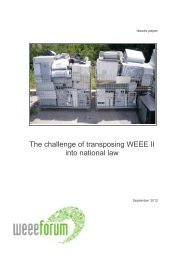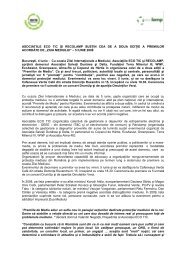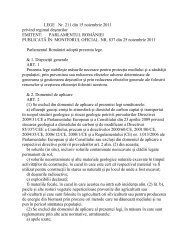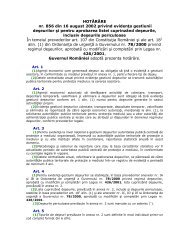PCB's in Small Capacitors from Waste Electrical and ... - Ecotic
PCB's in Small Capacitors from Waste Electrical and ... - Ecotic
PCB's in Small Capacitors from Waste Electrical and ... - Ecotic
Create successful ePaper yourself
Turn your PDF publications into a flip-book with our unique Google optimized e-Paper software.
4 Discussion on the Results<br />
4.1 Uncerta<strong>in</strong>ties with the Sample Preparation<br />
The vary<strong>in</strong>g results <strong>from</strong> the different laboratories on the<br />
same bulk sample for the PCB content approximate factor<br />
10 with regard to N° 1 “mixture of large household<br />
appliances” <strong>and</strong> N° 6 “ballasts <strong>in</strong> fl uorescent tube<br />
lamps”. Even with a complex matrix, such as shredded<br />
old capacitors, this is, on pr<strong>in</strong>ciple, not acceptable. An<br />
overall survey was therefore set to clarify the causes of<br />
the differences <strong>and</strong> fi nd out which results were the most<br />
reliable. Even an experienced PCB analyst could not<br />
fi n d a conclud<strong>in</strong>g answer to the two questions as,<br />
among others, gaps occurred <strong>in</strong> the specifi cations for<br />
methods <strong>and</strong> quality assurance systems of the laboratories.<br />
Potential sources of error with recondition<strong>in</strong>g <strong>and</strong><br />
splitt<strong>in</strong>g were identifi ed <strong>in</strong> the three laboratories. Insuffi -<br />
cient extraction yield may have caused the low values,<br />
while too high values can result <strong>from</strong> the unsatisfactory<br />
splitt<strong>in</strong>g of congeners, if, accord<strong>in</strong>g to the st<strong>and</strong>ard,<br />
they are multiplied with the factor follow<strong>in</strong>g LAGA. All <strong>in</strong><br />
all, we must assume that the real PCB contents are<br />
situated <strong>in</strong> the middle of the ranges given by Table 5.<br />
The values derived for <strong>in</strong>terpretation were calculated on<br />
the basis of these ranges. Anyway, for deriv<strong>in</strong>g conclusions,<br />
the analytical uncerta<strong>in</strong>ties are of m<strong>in</strong>or signifi -<br />
cance.<br />
For plausibility considerations <strong>and</strong> comparisons with<br />
analyses dat<strong>in</strong>g back about 20 years (BUWAL 1994), the<br />
number of PCB-conta<strong>in</strong><strong>in</strong>g capacitors was estimated<br />
<strong>from</strong> the PCB contents <strong>in</strong> Table 5. By assum<strong>in</strong>g a PCB<br />
share of 40 % <strong>in</strong> PCB-conta<strong>in</strong><strong>in</strong>g capacitors (KTAG<br />
1998) <strong>and</strong> an average weight for small capacitors reckoned<br />
accord<strong>in</strong>g to the correspond<strong>in</strong>g device category,<br />
we come to the absolute <strong>and</strong> percentual shares <strong>from</strong> the<br />
measured PCB contents of Table 8. It is a rough estimate,<br />
as these assumptions are not suffi c iently secured<br />
statistically. In spite of this reservation, these results allow<br />
a comparison with studies performed <strong>in</strong> 1988 (BU-<br />
WAL 1994). The decrease is signifi cant for all the device<br />
categories. Moreover, both studies reveal that the highest<br />
shares <strong>in</strong> PCB-conta<strong>in</strong><strong>in</strong>g capacitors orig<strong>in</strong>ate <strong>from</strong><br />
device categories averag<strong>in</strong>g the longest service life.<br />
Also this result is plausible.<br />
Table 8 Calculated number of PCB-conta<strong>in</strong><strong>in</strong>g capacitors, compared with 1988<br />
N° Orig<strong>in</strong> of <strong>Capacitors</strong> Average<br />
Weight<br />
[g]<br />
Number of<br />
<strong>Capacitors</strong>,<br />
R<strong>and</strong>om<br />
Sample<br />
[ – ]<br />
Large Household Appliances (LHA), <strong>Small</strong> Household Appliances (SHA)<br />
Number of<br />
PCB-<br />
Conta<strong>in</strong><strong>in</strong>g<br />
<strong>Capacitors</strong><br />
[ – ]<br />
Share<br />
1 LHA mixture 150 2’767 10–114 0.4–4.1 8.4<br />
2 Dishwashers 150 147 < 1 < 0.1 4.2<br />
3 SHA mixture, without microwave devices<br />
[ % ]<br />
Comparison<br />
BUWAL 1994 7<br />
[ % ]<br />
80 163 < 1 < 0.1 1.4<br />
4 Microwave devices 225 222 < 1 < 0.1 –<br />
5 Cool<strong>in</strong>g <strong>and</strong> freez<strong>in</strong>g appliances 100 1’480 < 1 < 0.1 0.5<br />
6 Ballasts <strong>in</strong> fl uorescent tube lamps 120 825 51–511 6.2–61.9 68.5<br />
IT (Information Technology) / CE (Consumer Electronics) / UPS (un<strong>in</strong>terruptible power supply systems)<br />
7 IT / CE: capacitors < 1 cm 10 2’100 < 1 < 0.1<br />
8 IT / CE: capacitors 1–2.5 cm 20 16’100 3 < 0.1<br />
9 IT / CE: capacitors > 2.5 cm 40 3’125 8–15 0.3–0.5<br />
10 UPS 500 534 < 1 < 0.1 –<br />
2.5<br />
7<br />
Specimens of 1988, share calculated <strong>from</strong> subcategories<br />
13









